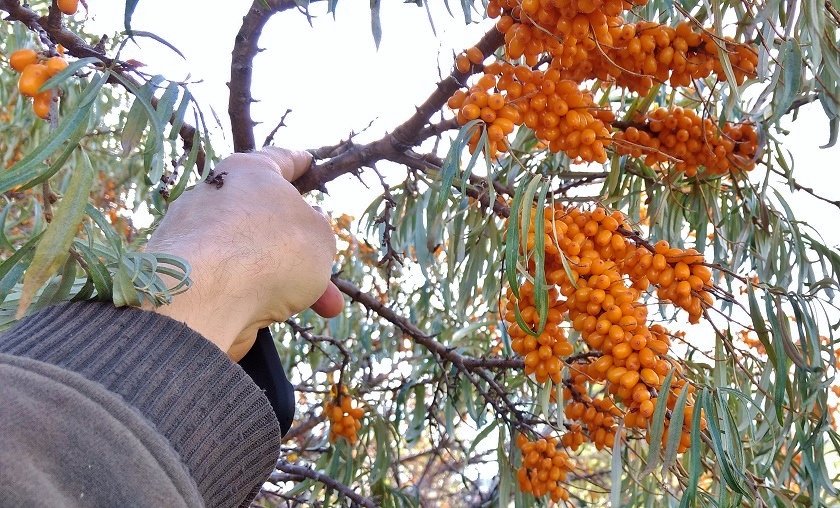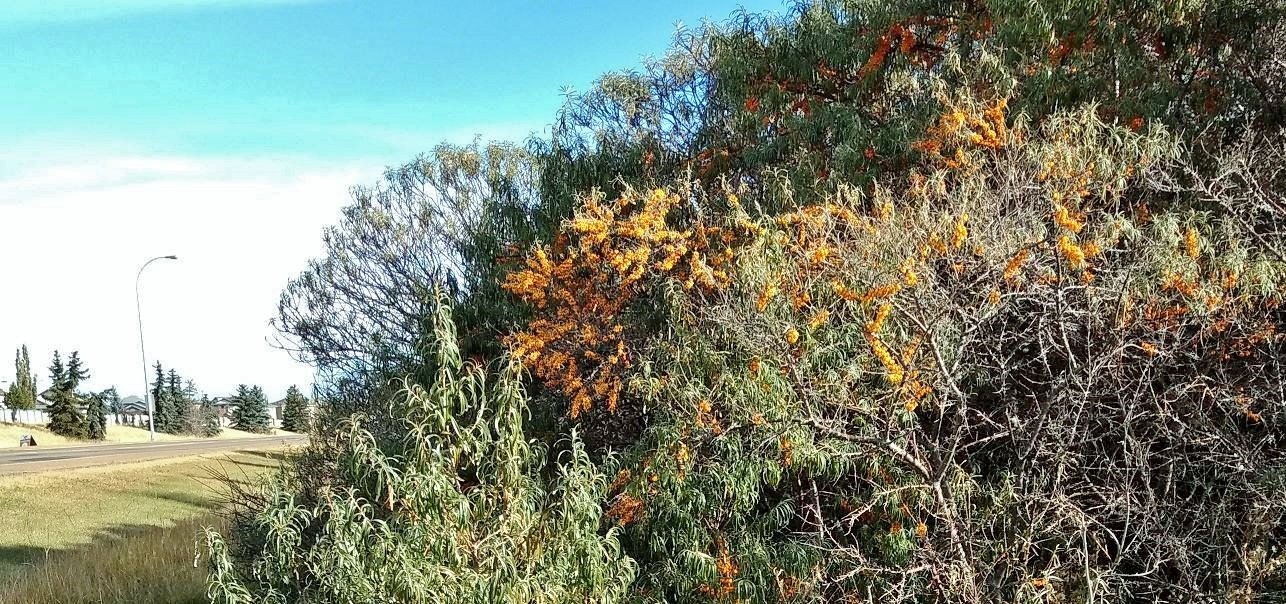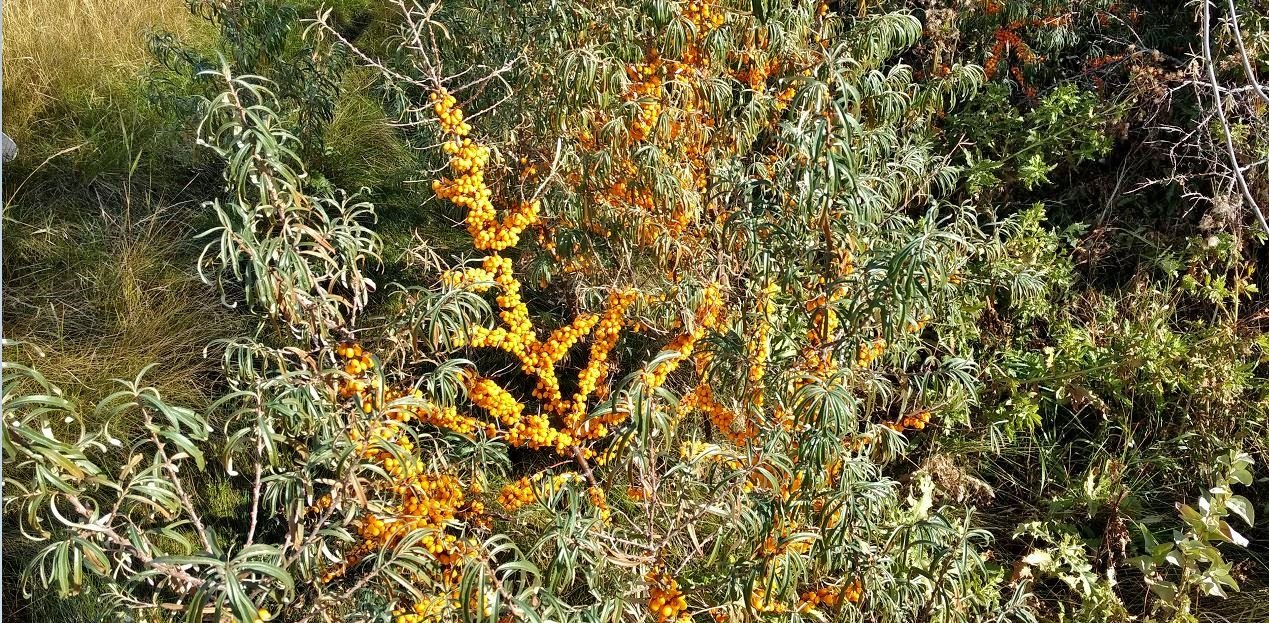
In the first edition of Permaculture Plants, I will be discussing one of the hardiest and most versatile shrubs that I know of, Sea Buckthorn! I have wanted to do a permaculture plants series for awhile but have been putting it off like a homework assignment for some unknown reason.
In this series, I will mainly be focusing on temperate permaculture plants, not only because I am already more familiar with them but because our property will be able to directly benefit from the additional research I will be conducting; many of the plants I will be highlighting will be utilized on our homestead.
Now, with the introduction out of the way, on to the plants!
Sea Buckthorn
Description
Common Sea Buckthorn (Hippophae rhamnoides), also known as Seaberry is an extremely versatile, large, nitrogen fixing shrub that is native to Europe and Asia. They have slender silvery green leaves, dense thorny branches and an equally dense root system, making them great for stabilizing loose soils. They are dioecious, which means there are both male and female plants.
Currently, Sea Buckthorn is most densely distributed in China, where there are large areas of both wild and cultivated plants. Because many of its many useful attributes, it is gaining a wider distribution in other countries like Canada. They will grow in a multitude of conditions, from sandy and dry to moist clay soils. In the wild, Sea Buckthorn can be found in coastal areas, along rivers and also in rocky mountainous areas and it is cold hardy from USDA zone 2b to 7.
Sea Buckthorn has a high saline and pollution tolerance making it ideal for repairing the most damaged soils. Historically, they have been used to help stabilize sand dunes on the eastern coasts of the United Kingdom and, in some areas, have continued to spread to the point of being considered invasive. Now, that is my type of plant!
 This Sea Buckthorn thicket is located on a large median in Edmonton
This Sea Buckthorn thicket is located on a large median in EdmontonI have noticed that they are often planted around Edmonton as ornamental shrubs near parking lots or in road medians where they would be exposed to saline, from the winter road salting, and plenty of exhaust pollution from all the heavy traffic. They seem to perform beautifully despite these harsh conditions.
Uses
The most obvious reason for growing Sea Buckthorn would be for the extremely abundant berries which, rightfully, can be considered a super food. These berries are absolutely packed with nutrition; containing extremely high concentrations of vitamin C as well as A, E, K and other nutrients. They also contain the full host of Omega fatty acids—3, 6, 7 and 9. There are named varieties of Sea Buckthorn that have been cultivated for significantly larger berries.

The berries can be a bit difficult to pick because they don't easily detach from the branch and tend to be damaged in the process. Due to this, and the berries extremely tart flavor, they are often used in juices, jams and other preserves rather than for fresh eating. They are also a popular ingredient in natural cosmetics due to the high levels of omega fatty acids and anti-oxidants.
 Source
SourceThe leaves of the plant can also be used as a medicinal tea. They have a mild green tea like flavor and have been shown in a couple of studies to have anti-oxidant and liver protective qualities. The leaves also contain up to 24% protein making them a great livestock feed. In fact, the first part of Sea Buckthorns Latin name Hippophae loosely translates to "shining horse." The ancient Greeks supposedly fed the leaves to their horses to impart a shiny coat.
Sea Buckthorn can grow anywhere from 10-20 feet tall and are considered a large to extra large shrub. They would fit into many permaculture designs in layer 2 (sub canopy) or layer 3 (shrub layer) and make a great companion plant or guild plant because they are nitrogen fixing and will enrich the surrounding soil. Caution needs to be taken that they aren't shaded out too much because they do prefer full sun and may not perform well in heavy shade. Due to their thorny nature, they also make great perimeter or boundary plants if planted in tight rows.
Growing Conditions, Propagation, and Maintenance
As already mentioned, Sea Buckthorn can thrive in a variety of conditions. They prefer full sun but can tolerate partial shade. They can also tolerate both dry to wet soils as long as the soils are well drained, and can tolerate a wide range in soil pH, from 5.5 to 8.5.
Both male and female plants are needed for fruit production and the most efficient ratios of male/female plants are said to be 1/8-10. Pollination occurs by wind only so strategic placement of the male plants in relation to the females might lead to greater production. Fruiting occurs most on two year old branches so if you are interested in maximum production some pruning could be beneficial.
 Look how these small plants are just loaded with berries!
Look how these small plants are just loaded with berries!Sea Buckthorn can be propagated in a variety of ways: by seed, soft or hard wood cuttings, layering, and also by transplanting suckers. If you decide to start from seed you may need to wait several years before the plants are large enough to be able to identify their sex. The seeds will yield approximately 50% male and female plants so if planted in the ground some of the males may need to be removed and replaced with females to maximize fruit production.
Sources:
https://en.wikipedia.org/wiki/Hippophae_rhamnoides#cite_note-Ruan_2010-14
https://tcpermaculture.blogspot.co.uk/2012/07/permaculture-plants-sea-buckthorn.html
http://coast.hope.ac.uk/media/liverpoolhope/contentassets/documents/coast/media,25634,en.pdf
